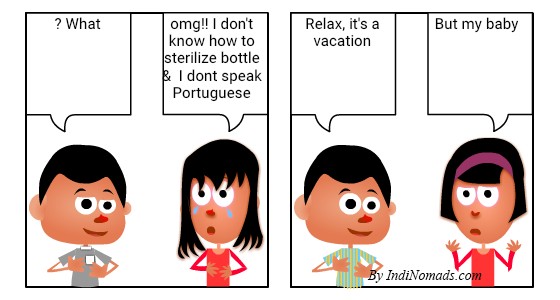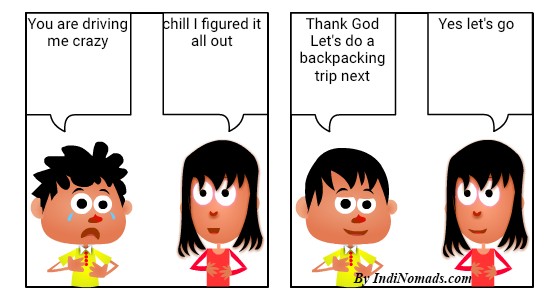We have been traveling with my son, now a 19-month old toddler, since he was 5 months old. Sterilizing his feeding bottles on hikes and travels has been one of the high priority tasks on all our trips. He has been to 7 countries and several camping trips and I finally nailed the process.
How to Sterilize baby bottle on hikes and travels?
For babies younger than 3-months or Premies, boiling water method is the best. According to USDA for babies older than 3 months, bottles should be thoroughly washed using soap and hot water. But, on hikes and travels the source of water can be unreliable. So, to be on the safer side, boil water and soak the bottle. If that’s not an option use Medela wipes to sterilize on hikes and travels.

Article Contents
Why sterilize at all ?
Well, it’s a no brainer. Babies can contract illnesses from microorganisms in bottles and nipples washed in contaminated water.
Especially in our case, we travelled with our son to Portugal, Spain, Guatemala, India, Mexico and Maldives while he was still bottle feeding. Personally even as an adults I wouldn’t just drink the tap water in most of these countries we visited. Portugal might be an exception.
On overnight hikes and backpacking trips where we camp for the night, the water source tends to vary.
Sometimes its water from the near by creek that was filtered or from the campground with potable water. In both of these situations, we generally drink boiled water.
This clearly means, I wouldn’t want to trust the water for just the soap & water cleaning method.
How do I get boiling water on the trips?
- Boiling on my own: If we are renting an airbnb or at campsite, I get to boil the water for myself. You can also take an electric kettle with you on trips if you are staying at hotels.
- Bathroom water: For example, we were at a small airport in Guatemala, but luckily there was hot water in the bathroom. I took the chance for the day and used that water to wash the bottle.
- Coffee shops / Restaurants: At airports, these are the best choices. Starbucks or just stop by at a restaurant and ask for boiling water. I always carry a thermos with me.
- Cold tap water: There has been instances where there was absolutely no hot water source, and I again I have taken chance to just washed with cold water.
- Ask the cabin crew: While on the board the plane, you can get as much boiling water as you want. Just ask.
Depending on where you live, if the tap water is safe to drink, probably it’s ok to just use the hot water or dishwasher to clean the bottle for babies older than 3 months.
How to clean bottles in flight / on the air or when you have just a thermos full of water?
Since there won’t be any big pot to clean, I just rinse them, sometimes without soap, in the bathroom.
However, I do this almost immediately after the feeding is done. It’s easier to wash off the sediments immediately, before they dry up.
I carry the following setup on the carry-on, wherever I go.
- Lightweight plastic container / Tupperware to keep the cleaned bottle & parts
- Small cleaning brush
- Travel size bottle of dish soap. I use the air friendly anti-leak ones
- Thermos
And use the Thermos cap to dip the nipple and ring into the hot water for few seconds. And pour hot-water directly into the bottle. This method has always worked for me. I haven’t had any issues so far.
How to clean the feeding bottle on hikes and camping ?
This is pretty straight forward. After the feeding is done, if I am still on the trail and hiking, I just rinse out the food particles with drinking water.
After reaching the campsite, I boil water with my Jet boil and soak them for a few mins.
How to clean the feeding bottle at hotel rooms ?
I have been at hotel rooms where they had kettle available upon request and other hotels where they didn’t even understand why I would need one.
If I am unsure, I just carry a travel kettle with me. Here the steps that I had followed that worked well.
- Turn on the kettle to boil water.
- I usually fill the Tupperware with soap water and use the brush to clean and rinse the bottle
- Spread out a clean towel and keep the washed bottle or parts aside
- After the water has boiled, pour hot water into the bottle
- And in the remaining water soak the nipple, lid, ring etc., for a few mins
- Fish out parts from the hot water and air dry them on a clean and dry towel
Boom…the bottles are clean and ready to be used.
When and how often ?
- End of the day or early in the morning before using them.
- Just once a day on the travels and hikes.
What would happen if I don’t sterilize for a day or two ?
I have personally been in this situation. Initially I used to freak out and constantly seek for hot water sources. But as we progressed through the travels, I have actually just washed in cold water for a day or two.
Again, in my case, my son was older than 3 months when we travelled. So, it was ok. Luckily he didn’t get sick because of water.
Sometimes, it’s just a matter of letting go. Some could argue why even travel and put the baby through the risk. Well, that’s a whole another conversation.
Why do I still sterilize the feeding bottle ?
My son is 19-months old and I still use the Dr.Brown’s feeding bottle with nipple size 4. Basically, he hasn’t graduated out of those bottles yet. We are working on straw bottle and a sippy-cup. He takes them for water and small amounts of liquid. Not for a full bottle of milk.
I just continue to sterilize them even at home. On trips and hikes, I would not take a chance with local water and stick to my sterilizing routine.
What do I do if I can’t find boiling water ?
There are a few different options out there for non-water methods.
- Bottle disposable liners: If I use this, at least the bottle itself doesn’t have to be washed. Just the nipple and ring need water to wash. However, on the hikes, this is an accumulated trash that we need to lug around until we find a trash can.
- Medela wipes have served me well while out and about. Again this is extra trash.
- Sterilon 7-day sterilizing solution: This is a chemical method to sterilize the bottle. I have personally not used it.
- Microwave Sterilizer: I have never used this. But I see how this can be useful on travels where the Airbnb or the hotel room has microwave option. Plus these are usually pretty light weight.
Lately, I am going through a change in my thought process. Well, I have an active toddler who touches everything in the backyard and chews on slippers, puts stones and wood chips or whatever he can grab into his mouth.
Why even sterilize given how his hands are probably dirtier than the bottle and nipple. However, I am yet to give up on sterilizing. I have a backpacking trip to Silver Peak wilderness in Big Sur area coming up during Memorial Day weekend in 2019. Let’s see how things go. After the trip is over, I will update this blog post.
In summary:
- Sterilize for sure if you are traveling with an infant under 3-months old or you have a premie.
- Older than 3-months, use your best judgement.
- Be flexible and be prepared to deal with every situation.
- Let go sometimes….this is a big one even for me. I am still learning to let go 🙂
Conclusion:
Keep a pack of Medela wipes with you. This is probably the most handy and useful option for on the go, when it comes to sterilizing feeding bottle or just about anything that your baby is likely to put in the mouth.
How about you ? Have you tried any other alternate ways to keep things clean for your baby ? Any tips for my upcoming trips ?
Would love to hear from your experience. Leave a comment below.

